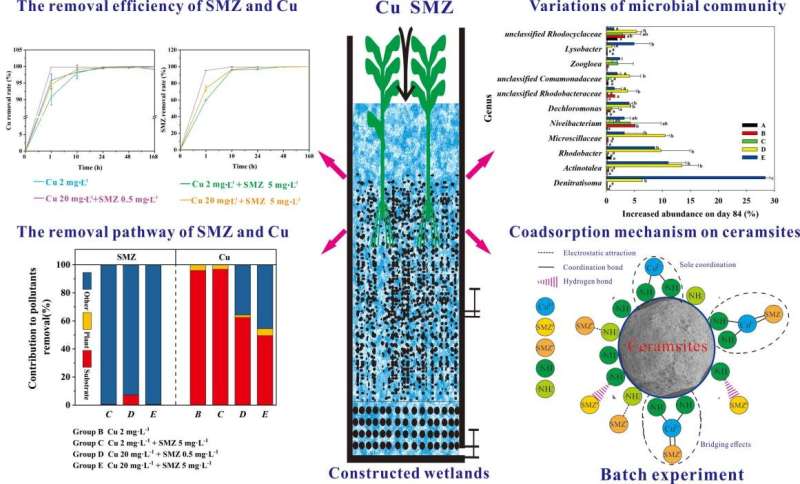This article has been reviewed according to Science X's editorial process and policies. Editors have highlighted the following attributes while ensuring the content's credibility:
fact-checked
trusted source
proofread
Study elucidates mechanisms of interaction and removal of coexisting contaminants in wetlands

Constructed wetlands (CWs) have attracted increasing attention for the reduction of heavy metals and antibiotics in tailwaters of livestock and poultry effluents due to their stable and considerable purification efficiency, low costs, and minimal land consumption. However, the coadsorption behaviors and mechanisms of coexisting heavy metals and antibiotics in CWs remain unclear.
Researchers from the Wuhan Botanical Garden and the Institute of Hydrobiology of the Chinese Academy of Sciences investigated the removal efficiency of heavy metals and antibiotics, as well as their migration characteristics and underlying interactions in CWs using small-scale CWs and laboratory dynamic adsorption experiments.
According to the researchers, the removal efficiency of sulfamethoxazole (SMZ) and copper (Cu) in CWs exceeded 99%. More than 50% of the Cu and SMZ reductions occurred after one hour, and about 90% of the contaminants were intercepted after ten hours.
Results were published in the Chemical Engineering Journal, titled "The occurrence characteristics and underlying removal mechanism of combined copper and sulfamethoxazole pollution in constructed wetlands."
Ceramsite adsorption was mainly responsible for Cu removal, and its contribution decreased by 39%–41% when the Cu concentration increased to 20 mg L-1. SMZ promoted the absorption and transfer of Cu in C. indica. The removal of SMZ in CWs was mainly dependent on microbial degradation, which accounted for more than 92% of the total removal.
The addition of 2 mg L-1 of Cu increased the bacterial diversity in CWs, and a high level of Cu (20 mg L-1) under SMZ stress conditions significantly increased the relative abundance of anaerobic denitrifying bacteria and SMZ-degrading bacteria.
In addition, Cu and SMZ exhibited complex competitive and synergistic adsorption effects on the ceramsite particle surfaces. Cu and SMZ adsorption capacities remained stable at pH values ranging from four to six and five to eleven, respectively. Additional cations had a positive effect on SMZ adsorption via hydrophobic interactions but had no effect on Cu adsorption.
In the combined system, absorbed Cu (II) on surface-neutral amine sites facilitated additional SMZ-coordination binding, because in SMZ, heterocyclic nitrogen (N) and sulfonamide N groups could both complex with Cu (II). Anionic SMZ bonded with protonated primary amines via electrostatic interactions, facilitating enhanced Cu-N coordination bonding.
This study provides a scientific basis for the application and optimization of CWs for the treatment of combined pollution in the tailwater of livestock and poultry farm effluents.
More information: Lin Ma et al, The occurrence characteristics and underlying removal mechanism of combined copper and sulfamethoxazole pollution in constructed wetlands, Chemical Engineering Journal (2023). DOI: 10.1016/j.cej.2023.143022
Provided by Chinese Academy of Sciences





















